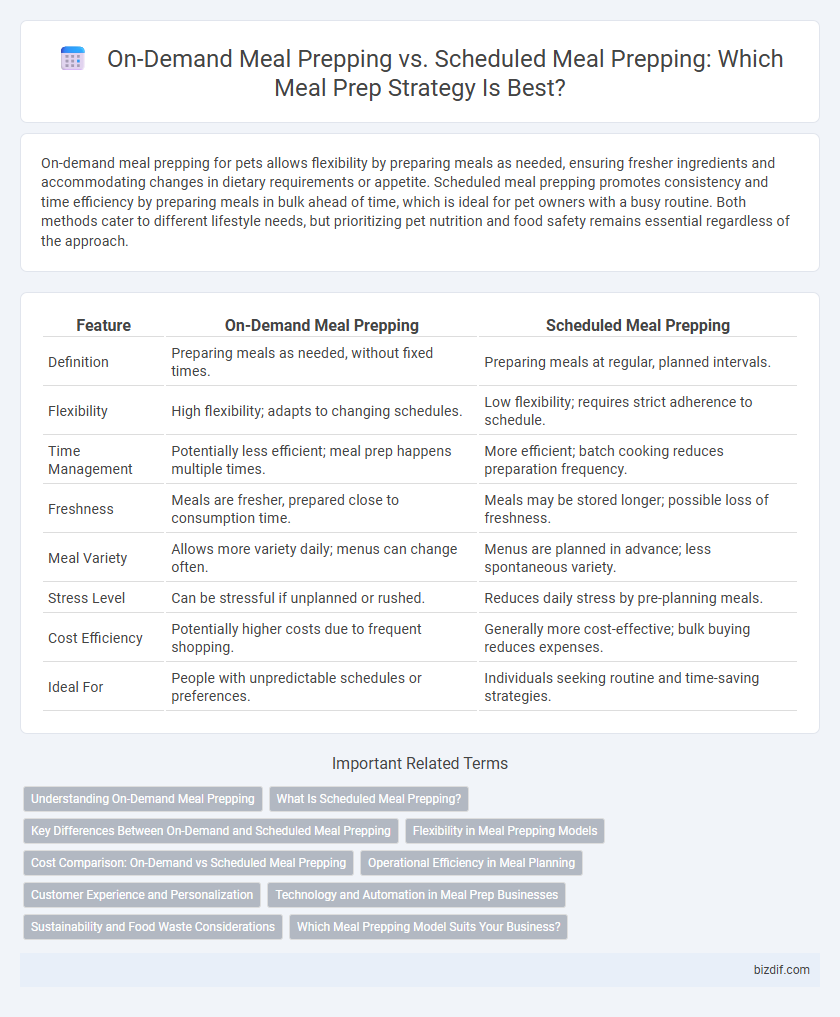On-demand meal prepping for pets allows flexibility by preparing meals as needed, ensuring fresher ingredients and accommodating changes in dietary requirements or appetite. Scheduled meal prepping promotes consistency and time efficiency by preparing meals in bulk ahead of time, which is ideal for pet owners with a busy routine. Both methods cater to different lifestyle needs, but prioritizing pet nutrition and food safety remains essential regardless of the approach.
Table of Comparison
| Feature | On-Demand Meal Prepping | Scheduled Meal Prepping |
|---|---|---|
| Definition | Preparing meals as needed, without fixed times. | Preparing meals at regular, planned intervals. |
| Flexibility | High flexibility; adapts to changing schedules. | Low flexibility; requires strict adherence to schedule. |
| Time Management | Potentially less efficient; meal prep happens multiple times. | More efficient; batch cooking reduces preparation frequency. |
| Freshness | Meals are fresher, prepared close to consumption time. | Meals may be stored longer; possible loss of freshness. |
| Meal Variety | Allows more variety daily; menus can change often. | Menus are planned in advance; less spontaneous variety. |
| Stress Level | Can be stressful if unplanned or rushed. | Reduces daily stress by pre-planning meals. |
| Cost Efficiency | Potentially higher costs due to frequent shopping. | Generally more cost-effective; bulk buying reduces expenses. |
| Ideal For | People with unpredictable schedules or preferences. | Individuals seeking routine and time-saving strategies. |
Understanding On-Demand Meal Prepping
On-demand meal prepping offers flexibility by allowing individuals to prepare meals as needed, reducing food waste and catering to fluctuating schedules. This method relies on quick planning and adaptable ingredient selections to meet immediate nutritional goals without the commitment of fixed meal plans. Understanding on-demand meal prepping enhances convenience for busy lifestyles while maintaining control over diet quality and portion sizes.
What Is Scheduled Meal Prepping?
Scheduled meal prepping involves planning and preparing meals at predetermined times, ensuring consistent availability of nutritious food throughout the week. This method streamlines grocery shopping, reduces daily cooking time, and helps maintain portion control and dietary goals. By adhering to a set schedule, individuals can improve meal variety and avoid last-minute food choices that may be unhealthy.
Key Differences Between On-Demand and Scheduled Meal Prepping
On-demand meal prepping offers flexibility by allowing individuals to prepare meals as needed, catering to spontaneous schedules and varying appetite levels. Scheduled meal prepping involves planning and cooking meals in advance for the entire week, promoting consistency, portion control, and time efficiency. Key differences include timing, customization, and resource management, with on-demand focusing on immediate needs and scheduled prepping emphasizing routine and long-term nutritional goals.
Flexibility in Meal Prepping Models
On-demand meal prepping offers maximum flexibility by allowing individuals to prepare meals based on immediate needs and availability, catering to unpredictable schedules. Scheduled meal prepping involves planning and preparing meals in advance on fixed days, which enhances consistency and time efficiency during busy weeks. Choosing between these models depends on balancing convenience with personal lifestyle demands and dietary goals.
Cost Comparison: On-Demand vs Scheduled Meal Prepping
On-demand meal prepping typically incurs higher costs per meal due to last-minute grocery purchases and smaller batch cooking, while scheduled meal prepping benefits from bulk buying and efficient ingredient utilization, driving down overall expenses. Scheduled meal preppers often save up to 30% on food costs by planning meals around weekly promotions and reducing food waste. Comparing both methods, scheduled meal prepping offers a more budget-friendly approach for maintaining a consistent and nutritious diet.
Operational Efficiency in Meal Planning
On-demand meal prepping enhances operational efficiency by allowing flexible meal preparation based on real-time needs, reducing food waste and inventory costs. Scheduled meal prepping streamlines bulk purchasing and batch cooking processes, optimizing ingredient utilization and minimizing prep time. Both methods improve meal planning workflows but differ in adaptability and resource management effectiveness.
Customer Experience and Personalization
On-demand meal prepping offers unparalleled flexibility, allowing customers to customize meals based on daily preferences and nutritional needs, enhancing personalization and satisfaction. Scheduled meal prepping provides a structured experience with consistent delivery times, ensuring reliability and ease of planning for busy lifestyles. Both approaches improve customer experience by catering to different needs: on-demand maximizes adaptability, while scheduled builds routine and trust.
Technology and Automation in Meal Prep Businesses
On-demand meal prepping leverages advanced technology platforms and AI-driven algorithms to customize meals quickly based on real-time customer preferences, enhancing flexibility and responsiveness. Scheduled meal prepping businesses utilize automation tools such as inventory management systems and predictive analytics to streamline operations, reduce waste, and ensure timely delivery. Both approaches rely heavily on digital integration, including mobile apps and cloud-based software, to optimize meal planning, production, and customer engagement in the meal prep industry.
Sustainability and Food Waste Considerations
On-demand meal prepping reduces food waste by allowing precise ingredient usage tailored to immediate needs, minimizing over-purchasing and spoilage. Scheduled meal prepping enhances sustainability by enabling bulk buying and efficient meal planning, which decreases packaging waste and lowers overall environmental impact. Both approaches demand mindful consumption patterns to optimize resource use and reduce food waste effectively.
Which Meal Prepping Model Suits Your Business?
Choosing between on-demand and scheduled meal prepping depends on your business goals and customer preferences. On-demand meal prepping offers flexibility and caters to last-minute orders, ideal for businesses targeting busy professionals seeking convenience. Scheduled meal prepping ensures consistent production and supply chain efficiency, suited for companies focusing on subscription models and predictable revenue streams.
On-demand meal prepping vs scheduled meal prepping Infographic

 bizdif.com
bizdif.com